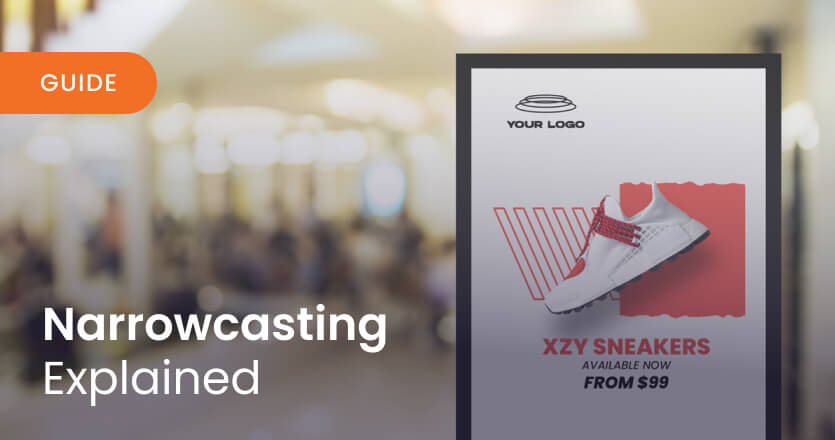If you want to facilitate more targeted communications, narrowcasting is an excellent approach. But what is narrowcasting, exactly? Here, we’ll cover what it is, how to narrowcast with digital displays for digital signage, and the benefits it offers to all types of businesses.
What is narrowcasting?
Narrowcasting is an effective communication tool for displaying media, content, or information on screens, aimed at a narrow audience. Whatever sector you are in, it allows you to focus on a select audience or location with tailored messaging.
What’s the difference between narrowcasting and broadcasting?
Essentially, broadcasting and narrowcasting communicate messages in opposite ways. Narrowcasting is a form of digital signage that aims customized media messaging to a specific audience. On the other hand, broadcasting aims to appeal to a wide audience with mass marketing messaging. Crucially, narrowcasting offers the opportunity to reach a selected audience with highly targeted and customized campaigns and content that appeals specifically to those viewers.
Narrowcasting examples
Examples of narrowcasting media include all types of modern ways to reach specific groups of people you will be familiar with, such as:
- YouTube
- Podcasts
- Cable TV
- Digital displays
- Mailing lists to subscribers
- Subscription-centric websites
Typically, narrowcasting with digital displays in out-of-home settings deals with informative or commercial communications, including:
- Customer messaging (menu boards, sales promos, loyalty program materials)
- Employee messaging (digital meeting room signage, recognitions/announcements, TV dashboard displays)
- Visitor messaging (welcome messages, emergency alerts, safety reminders,wayfinding digital signage)
- Educational messaging (training, RSS feeds, digital information boards/display class schedules)
Whoever the selected audience is, the environment and screen location is important too. For example, the Point of Sale (POS) in a retail or restaurant, or the Point of Wait (POW) in places like offices, hospitals, hotels, and cultural organizations, must be carefully thought out to reach an audience optimally.
Advantages of narrowcasting
Here are some of the ways that narrowcasting can help you communicate effectively and grow your business:
Audience targeting
Do you want to bring attention to a service, product or offer? Then target a segment of the market or geographic area with tailored, custom content through narrowcasting. You’ll be able to communicate more personalized messaging to the right audience, at the right time, in the right place.
Content formats
Narrowcasting creates the possibility to present content in a full range of formats, from static images, templates and PowerPoint presentations to video, audio, or auto-updating content.
So, you can inform and engage your target group with dynamic digital media, whether it’s for promotional purposes or operational activities.
Cost-effectiveness
Sharing your message in a narrowcast can be more effective for business. Economically, narrowcasting digital signage content only involves an initial set up cost, then ongoing management through a content management system (CMS). Overall, narrowcasting can offer a better ROI by communicating with a highly targeted audience.
Using Yodeck to narrowcast digital displays
Yodeck is an all-in-one, affordable screen communication solution for narrowcasting with digital signage. To get started, Yodeck provides a media player (free with an annual plan) and user-friendly digital signage software that supports any screen with an HDMI port.
Users can quickly upload whatever type of media they want to Yodeck’s digital signage content management system (CMS) platform. Videos and live streams (YouTube, Ustream, and custom streams), apps, and document files like PowerPoint are all supported in order to facilitate making personalized content for a chosen audience.
Once uploaded, it’s simple to schedule exactly when and where the media gets displayed. Even when remote, it’s easy to update content on the fly from a laptop or smartphone. It’s also possible to assign users to specific content and monitors, which is ideal for managing the scheduling of a narrowcast to particular target groups in one or more locations.
